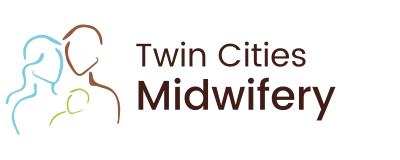10 Jul Twin Cities Midwifery’s Cesarean Rate and Other Statistics
by Kate Saumweber Hogan, CPM, LM, owner of Twin Cities Midwifery, LLC
When I meet with families who are looking to choose a midwife, I am often asked about the statistics available for my home birth practice. While I do gather data, the small size of my practice brings the usefulness of these particular rates into question. With such a small pool of data, how statistically significant would these numbers be? Thus, I often direct families to studies that look at a much larger pool of data than mine.
Home birth studies shed light on safety and other key indicators
A number of studies demonstrate the safety of planned home birth for healthy, low-risk women with a trained attendant, such as this one from Canada, or this one from the Netherlands. An article by Johnson and Daviss, “Outcomes of planned home births with certified professional midwives: large prospective study in North America,” is especially important in that it uses data from planned home births in the U.S., and it not only addresses safety but also looks at hospital transport rates, cesarean rates, and other statistics that families commonly ask about.
Birth statistics are becoming more freely available
Over the past few years, I have noticed that hospitals and clinics are becoming more transparent in the care they provide. There is still a long road ahead of them, but due to the demand from informed consumers (pregnant people and families!), data on interventions like cesarean sections is becoming easier and easier to find. Annually, a report comes to my email discussing the cesarean rates by Minnesota hospital and Wisconsin hospital, and recently, I came across one that detailed rates by clinic (starting on page 192). I think it is fantastic that families have this information accessible to them as they choose a provider and consider who will walk with them on their journey of pregnancy, birth, and postpartum care.
I’m also inspired by our very own, local Childbirth Collective, which started a data-gathering project last year to learn more about the births its doula members attend. I look forward to reading their report of 2012 births that is set to be released later this year.
Statistics are a mirror that help us see and improve practice
I have been amazed by how Twin Cities Midwifery has grown and flourished over the past two-and-a-half years. I still limit my practice to about 2-4 due dates a month, and there are certain months when I plan ahead, not taking any due dates, allowing for a planned vacation, or a birth in my own family. This means that the pool of data is still small, but I need to start somewhere. I intend to update my statistics annually to provide a level of transparency to families wanting to learn more about my practice.
I know that the numbers will ebb and flow. I think that the Johnson and Daviss article gives good estimates of where my statistics will eventually hover around. For example, when they looked at all home births attended by certified professional midwives in the U.S. and Canada in 2000, they found:
- 12.1% of women who intended to deliver at home when labor began were transferred to hospital.
Medical intervention rates included:
- Epidural: 4.7%
- Forceps: 1.0%
- Vacuum extraction: 0.6%
- Caesarean section: 3.7%
As you will read below, thus far Twin Cities Midwifery has a 0% cesarean rate. No, that is not a typo—so far none of the women in my practice have needed a cesarean. However, I know that will change. Actually, think that just putting it in writing will jinx it and make it change really fast! And that is okay. Eventually, there will be a need for a cesarean in my practice. All obstetrical interventions have a place, and I’m glad that I practice in an area where we have access to wonderful hospital care when it is needed. Being able to transport when we need to and receiving appropriate care in the hospital is what makes planning a home birth so safe; when we need extra help, we get it.
The problem we have in our country is not that women have cesareans, but that so many have unnecessary cesareans (which in turn cause additional health problems for moms and babies). Just like all obstetrical interventions, when overused, they can cause more harm than good. The Childbirth Connection has a useful article about why our national cesarean rate of 32.8% is so high. According to the article, the optimal cesarean rate is 5%-10% for the general population. Since home birth midwives work with an exceptionally healthy and low-risk population, it would make sense for the rate in this population to be lower. The Johnson and Daviss study found a 3.7% cesarean rate.
So what are Twin Cities Midwifery’s initial stats?
These statistics below encompass all 56 women who established care for their pregnancies from when I started Twin Cities Midwifery in December of 2010 with due dates through July, 2013. In this two-and-a-half year period, 57.1% (32) of my clients were first-time moms, and 42.9% (24) were experiencing a subsequent pregnancy. Unfortunately, 7.1% (4) of the pregnancies ended in miscarriage. Another 12.5% (7) transferred out of my care during their pregnancy (for reasons such as preterm rupture of membranes, signs of pre-eclampsia, or moving out of the area). Out of all of these families, 8.9% (5) transfered to the hospital during labor.

Place of birth for all Twin Cities Midwifery pregnancies with due dates between December 2010 and July 2013
Of all of the 45 women who were under my care when their labor started, 51.1% (23) were first time moms, and 48.9% (22) were experiencing their second, third, or sixth labors.
Of the babies I helped to welcome in the world, 37.8% (17) were girls, and 62.2% (28) were boys.
A doula was present at 51.1% (23) of these labors; 52.2% (12) of first-time moms had a doula, while 50% (11) of mothers of two or more had a doula with them.
Of these 45 women who intended to deliver at home when labor began, 88.9% (40) gave birth at home, meaning that we transferred 11.1% (5) of these labors to the hospital. All of the hospital transfers were for first-time moms and were non-urgent; one transfer was due to signs of infection during labor, and the others were due to very long labors with a labor progression that slowed or had stopped (interestingly, none of the families who had to transfer for slow or no progress had chosen to have a doula at their birth).
Due to transfers to the hospital during labor, my practice has an epidural rate of 8.9% (4) and a pitocin augmentation rate of 8.9% (4). All of the women who transferred gave birth vaginally; 2.2% (1) were assisted by vacuum, and 2.2% (1) were assisted by forceps. Twin Cities Midwifery’s cesarean rate is 0%.
We have had a 2.2% (1) postpartum transfer rate (going to the hospital for extra care for mom after baby arrives) and a 2.2% (1) newborn transfer rate. These transports were also non-urgent.
Toward healthier, safer births for moms and babies in Minnesota
I am honored to have attended each and every one of these births and am so grateful for the opportunity to be with families during this incredibly special time. I look forward to our regular TCM events so that I get to watch these babies grow! With this midwifery model of care, Twin Cities Midwifery is helping to lower our state’s cesarean rate in a healthy and safe way, one birth at a time.




The Birth Story of Violet Jane | Twin Cities Midwifery Blog
Posted at 10:06h, 20 July[…] Mamas, and dads, please(!) take this choice seriously. All families have the option to consider out of hospital birth, because of strong, caring women like our midwife. She kept us safe and made sure we were healthy, […]